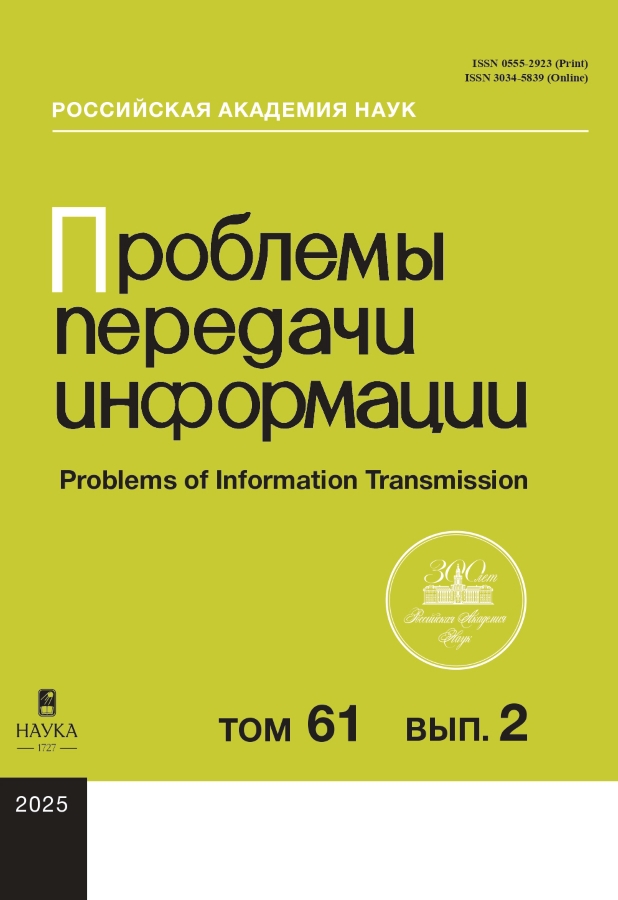Convolutional Codes with Optimum Bidirectional Distance Profile
- Authors: Stanojevi´c I.1, Senk V.1
-
Affiliations:
- Faculty of Technical Sciences, University of Novi Sad
- Issue: Vol 59, No 3 (2023)
- Pages: 3-25
- Section: Coding Theory
- URL: https://ruspoj.com/0555-2923/article/view/667564
- DOI: https://doi.org/10.31857/S0555292323030014
- EDN: https://elibrary.ru/FQBJWI
- ID: 667564
Cite item
Abstract
We define the bidirectional distance profile (BDP) of a convolutional code as the minimum of the distance profiles of the code and its corresponding “reverse” code. We present tables of codes with the optimum BDP (OBDP), which minimize the average complexity of bidirectional sequential decoding algorithms. The computer search is accelerated by the facts that optimum distance profile (ODP) codes of larger memory must have ODP codes of smaller memory as their “prefixes”, and that OBDP codes can be obtained by “concatenating” ODP and reverse ODP codes of smaller memory. We compare the performance of OBDP codes and other codes by simulation.
About the authors
I. Stanojevi´c
Faculty of Technical Sciences, University of Novi Sad
Email: cet_ivan@uns.ac.rs
Novi Sad, Serbia
V. Senk
Faculty of Technical Sciences, University of Novi Sad
Author for correspondence.
Email: vojin_senk@uns.ac.rs
Novi Sad, Serbia
References
- Johannesson R., Zigangirov K.Sh. Fundamentals of Convolutional Coding. Piscataway, NJ: IEEE Press; Hoboken, NJ: Wiley, 2015.
- Зигангиров К.Ш. Некоторые последовательные процедуры декодирования // Пробл. передачи информ. 1966. Т. 2. № 4. С. 13–25. https://www.mathnet.ru/ppi1966
- Jelinek F. Fast Sequential Decoding Algorithm Using a Stack // IBM J. Res. Develop. 1969.V. 13. № 6. P. 675–685. https://doi.org/10.1147/rd.136.0675
- Fano R.M. A Heuristic Discussion of Probabilistic Decoding // IEEE Trans. Inform. Theory. 1963. V. 9. № 2. P. 64–74. https://doi.org/10.1109/TIT.1963.1057827
- Chevillat P., Costello D. An Analysis of Sequential Decoding for Specific Time-Invariant Convolutional Codes // IEEE Trans. Inform. Theory. 1978. V. 24. № 4. P. 443–451. https://doi.org/10.1109/TIT.1978.1055916
- Narayanaswamy B., Negi R., Khosla P. An Analysis of the Computational Complexity of Sequential Decoding of Specific Tree Codes over Gaussian Channels // Proc. 2008 IEEE Int. Symp. on Information Theory (ISIT’2008). Toronto, ON, Canada. July 6–11, 2008. P. 2508–2512. https://doi.org/10.1109/ISIT.2008.4595443
- Johannesson R. Robustly Optimal Rate One-Half Binary Convolutional Codes // IEEE Trans. Inform. Theory. 1975. V. 21. № 4. P. 464–468. https://doi.org/10.1109/TIT.1975.1055397
- Johannesson R. Some Long Rate One-Half Binary Convolutional Codes with an Optimum Distance Profile // IEEE Trans. Inform. Theory. 1976. V. 22. № 5. P. 629–631. https://doi.org/10.1109/TIT.1976.1055599
- Johannesson R. Some Rate 1/3 and 1/4 Binary Convolutional Codes with an Optimum Distance Profile // IEEE Trans. Inform. Theory. 1977. V. 23. № 2. P. 281–283. https://doi.org/10.1109/TIT.1977.1055687
- Hagenauer J. High Rate Convolutional Codes with Good Distance Profiles // IEEE Trans. Inform. Theory. 1977. V. 23. № 5. P. 615–618. https://doi.org/10.1109/TIT.1977.1055777
- Johannesson R., Paaske E. Further Results on Binary Convolutional Codes with an Op- timum Distance Profile // IEEE Trans. Inform. Theory. 1978. V. 24. № 2. P. 264–268. https://doi.org/10.1109/TIT.1978.1055850
- Johannesson R., St˚ahl P. New Rate 1/2, 1/3, and 1/4 Binary Convolutional Encoders with an Optimum Distance Profile // IEEE Trans. Inform. Theory. 1999. V. 45. № 5. P. 1653–1658. https://doi.org/10.1109/18.771238
- Sone N., Mohri M., Morii M., Sasano H. Optimal Free Distance Convolutional Codes for Rates 1/2, 1/3, and 1/4 // Electron. Lett. 1999. V. 35. № 15. P. 1240–1241. https://doi. org/10.1049/el:19990871
- Frenger P., Orten P., Ottosson T. Convolutional Codes with Optimum Distance Spec- trum // IEEE Commun. Lett. 1999. V. 3. № 11. P. 317–319. https://doi.org/10.1109/4234.803468
- Hug F. Codes on Graphs and More: Ph.D. Thesis. Dept. of Electrical and Information Technology, Lund Univ., Lund, Sweden, 2012.
- Sˇenk V., Radivojac P. The Bidirectional Stack Algorithm // Proc. 1997 IEEE Int. Symp. on Information Theory (ISIT’97). Ulm, Germany. June 29 – July 4, 1997. P. 500. https://doi.org/10.1109/ISIT.1997.613437
- Kallel S., Li K. Bidirectional Sequential Decoding // IEEE Trans. Inform. Theory. 1997. V. 43. № 4. P. 1319–1326. https://doi.org/10.1109/18.605602
- Bocharova I.E., Handlery M., Johannesson R., Kudryashov B.D. BEAST Decoding of Block Codes Obtained via Convolutional Codes // IEEE Trans. Inform. Theory. 2005. V. 51. № 5. P. 1880–1891. https://doi.org/10.1109/TIT.2005.846448
- Xu R., Kocak T., Woodward G., Morris K., Dolwin C. High Throughput Parallel Fano Decoding // IEEE Trans. Commun. 2011. V. 59. № 9. P. 2394–2405. https://doi.org/10. 1109/TCOMM.2011.062011.100236
- Stanojevi´c I., Sˇenk V. Convolutional Codes with Optimum Bidirectional Distance Profile, https://arXiv:2210.15787v4 [cs.IT], 2022.
Supplementary files











